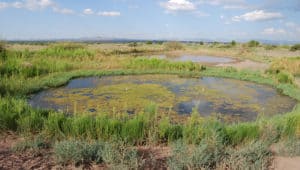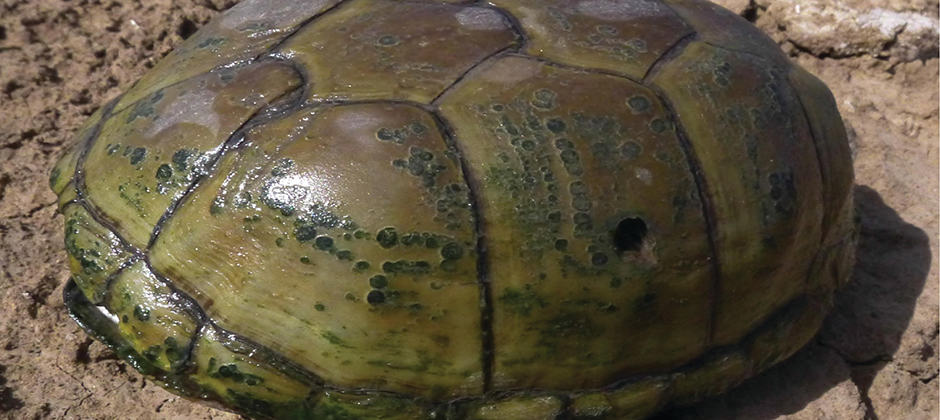Share this article
Researchers discover shell disease in Texas mud turtles
Researchers have discovered a new shell-eating disease, caused by a common alga, that affects mud turtles throughout their range.
There’s high prevalence of the disease, particularly in certain arid parts of Texas, where the turtles have permanent, but artificial, water sources in the form of cattle tanks.
“The turtles that have access to this water and have a permanent resource to depend on every year have more of a chance to catch this disease,” said Travis LaDuc, Curator of Herpetology at the Biodiversity Collections at the University of Texas at Austin and one of the co-authors of a study published recently in the Journal of Herpetology.
Researchers conducted a large survey of wildlife and plants at a private cattle ranch in the Chihuahuan Desert of West Texas in 1948, collecting a large number of specimens that were stored at the University of Texas at Austin. LaDuc had always wanted to go back and see if things had changed.
When he and his colleagues returned to survey reptiles and amphibians, they found that the landowners had done an “outstanding job” of taking care of their property — herpetological biodiversity on their property hadn’t changed much in more than half a century.
He had also discovered a large number of yellow mud turtles (Kinosternon flavescens) on the property. As part of a side project to the larger survey, he began a survey of yellow mud turtles in 2006, conducting a mark-recapture study on about 800 turtles for 14 years now.
“It’s been an amazing dataset to work on,” LaDuc said.
Early on in the surveys, LaDuc and his colleagues started noticing something different about many of the turtles’ shells. They were covered in a common alga, Arnoldiella chelonum, and had deteriorating shell conditions.
Throughout the years, as researchers recaptured some of the same reptiles, they noticed that the conditions of the shells got progressively worse, with increasing numbers of lesions. They realized that shell condition and algae were likely linked.
They looked through museum specimens of yellow mud turtles from around the country and examined photos of the turtles on iNaturalist — a citizen science platform in which users upload photos of wildlife. Roughly half the iNaturalist photos were of high enough quality that researchers could determine whether the algae were present, giving them a better sense of disease distribution.
Looking at museum specimens that went back more than 100 years, the team found algae presence and shell lesions on a yellow mud turtle specimen dating back to 1891.
Some shell diseases can cause big problems for turtles. The shell-eating disease caused by the recently described Emydomyces testavorans fungus resulted in the euthanasia of some captive turtles. But this disease process, which LaDuc and his colleagues named the Carapacial Shell Disease Process, or CSDP, is different. It’s caused by algae rather than fungus.
LaDuc said that while the disease is found widely throughout mud turtles’ range, it is particularly prevalent at the ranch he is surveying, and he thinks it has to do with year-round water supply tanks.

Glidewell Pond was the main site for the mark-recapture study on yellow mud turtles.
©Drew Davis
This type of algae affects other turtles, primarily aquatic species, like snapping turtles (Chelydra serpentina). Historically, yellow mud turtles in the Chihuahuan Desert only have access to water in short bouts during the rainy season. But at the ranch where LaDuc was conducting his research, earthen water tanks had been placed year-round for grazing cattle and wildlife.
In many ways, this water is a boon for yellow mud turtles, which abound in the area, but LaDuc believes the way the mud turtles use it might also be giving the algae an opportunity to penetrate into turtle shells more deeply than it would in animals adapted to spending longer periods in the water like snapping turtles.
Once the algae penetrates under the keratinous outer layer of mud turtle shells, it can persist throughout drier periods when the turtles disperse between water tanks or elsewhere in the area. The algae can survive even while the reptiles hibernate in dry conditions for six to nine months, getting revitalized the next time the turtle enters a cattle tank.
At these cattle tanks, the alga is so prevalent that nearly every turtle that researchers mark and recapture show evidence of the disease by the time it reaches 10 years old.
LaDuc said he isn’t sure what the effects of the disease are. The disease doesn’t appear fatal since it doesn’t destroy the bony shell, only the keratin scutes that overlay the bone. But he said it may make animals more vulnerable to desiccation — or extreme dryness — when they disperse from the ponds.
Header Image: A yellow mud turtle shows enlarged pits on its carapace — signs of the recently described algae-associated shell disease showing. The larger single hole is the result of a predation attempt. ©Drew Davis








